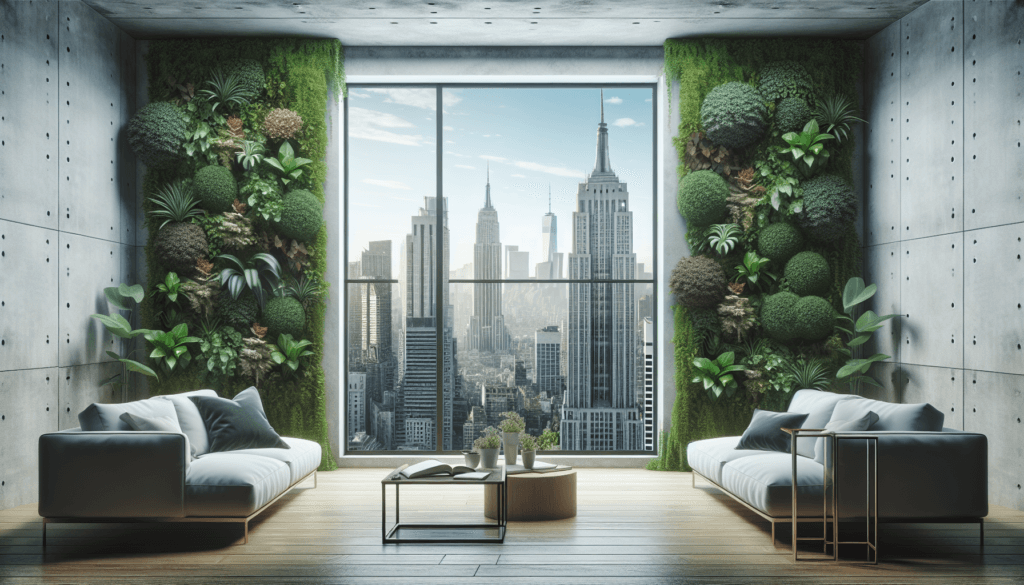Are you tired of the concrete jungle that is your urban home? Yearning for a touch of nature amidst the chaos of city living? Look no further! In this article, you will discover the secrets to creating a living wall in your urban home, transforming your space into a lush oasis. Whether you have a spacious backyard or a tiny balcony, we will guide you through the process of bringing vertical greenery into your living environment. Say goodbye to the monotony of plain walls and hello to a vibrant, thriving wall of life right in your own home. Get ready to embark on a journey of creativity and sustainability as we explore the art of creating a living wall in your urban sanctuary.
Choosing the right location
Assessing sunlight availability
When choosing a location for your living wall, one of the most important factors to consider is sunlight availability. Most plants require a certain amount of sunlight to thrive, so it’s crucial to assess how much direct sunlight your chosen location receives.
Start by observing the area at different times of the day to determine the intensity and duration of sunlight. Keep in mind that the amount of sunlight may vary depending on the season. Ideally, your living wall should receive at least six hours of direct sunlight each day, but there are also plants that can tolerate lower light conditions if needed.
Considering wall space
Another aspect to consider when choosing the location for your living wall is the available wall space. Ensure that the wall you select is sturdy enough to support the weight of the living wall system, plants, and the growing medium.
Measure the dimensions of the wall and consider any obstacles such as windows, doors, or vents that may limit the available space. Additionally, take into account the visual impact of the living wall and how it will fit within the overall aesthetic of your urban home.
Evaluating access to water source
Creating a successful living wall also requires easy access to a water source. Since plants in a living wall need regular watering, it’s important to evaluate the proximity of your chosen wall to a water supply.
Consider whether there is access to a tap or hose nearby, or if you need to install a watering system specifically for your living wall project. Ensuring sufficient access to water will make it easier to maintain the health and vitality of your living wall over time.
Selecting suitable plants
Determining plant types
Once you have chosen the location for your living wall, it’s time to select the suitable plants that will thrive in this environment. Different plants have varying needs in terms of light, water, and temperature, so it’s essential to do your research before making any plant selections.
Consider factors such as the overall design and aesthetic you want to achieve, as well as the specific growing requirements of each plant. Think about combining different plant types and textures to create an appealing and visually interesting living wall.
Researching suitability for indoor conditions
If you’re creating a living wall indoors, it’s crucial to choose plants that are suitable for indoor conditions. Indoor environments often have lower light levels and different temperature and humidity levels compared to outdoor settings.
Research suitable indoor plants that thrive in low light conditions, tolerate temperature fluctuations, and have low water requirements. Opting for plants that are resilient and adaptable to indoor environments will increase your chances of success.
Considering maintenance requirements
Another important consideration when selecting plants for your living wall is the maintenance requirements associated with each plant. Some plants may require regular pruning, feeding, or specific care instructions to thrive.
Consider your personal schedule and commitment to plant maintenance before selecting plants. If you have limited time or prefer low-maintenance options, choose plants that are known to be hardy and require minimal care.

Preparing the wall
Cleaning the surface
Before installing the living wall system, it’s crucial to prepare the wall by thoroughly cleaning the surface. Remove any dirt, debris, or loose paint from the wall using a stiff brush or pressure washer.
Ensure that the wall is free from any substances that may prevent the living wall system from properly adhering to the surface. A clean surface will provide a solid foundation for the installation process.
Repairing any damages
Inspect the wall for any damages such as cracks, holes, or water leaks. It’s essential to address these issues before installing the living wall system to prevent further damage or water penetration.
Fill any cracks or holes with an appropriate filler and allow it to dry completely. Repairing damages will ensure that your living wall has a structurally sound and stable foundation.
Applying a waterproof membrane
To protect the wall from moisture and potential water damage, it’s recommended to apply a waterproof membrane. This will create a barrier between the living wall system and the wall, preventing water from seeping into the structural layers of the wall.
Choose a high-quality waterproof membrane and apply it according to the manufacturer’s instructions. This step is crucial in ensuring the longevity and durability of your living wall.
Installing the framework
Choosing appropriate support structure
The framework is a vital component of a living wall as it provides support for the plants and the growing medium. When selecting a framework, consider the weight-bearing capacity, durability, and design aesthetics.
Choose a framework that is specifically designed for living walls and is suitable for your chosen wall location. Ensure that the structure is strong enough to support the weight of the plants and the growing medium without compromising the integrity of the wall.
Determining spacing and layout
Before installing the framework, determine the spacing and layout of the plants. Consider the growth habits and mature sizes of the selected plants to ensure adequate spacing between each plant.
Create a layout plan that allows enough room for each plant to grow and thrive without overcrowding or shading their neighboring plants. A well-thought-out spacing and layout will contribute to the overall visual appeal and health of your living wall.
Attaching the framework to the wall
Once you have determined the spacing and layout, it’s time to attach the framework to the wall. Following the manufacturer’s instructions, securely fasten the framework to the wall, ensuring that it is level and stable.
Use appropriate installation methods such as screws, anchors, or brackets, depending on the type of framework and the wall material. Take your time to ensure that the framework is securely attached as it will provide the foundation for your living wall.

Creating a drainage system
Installing a waterproof tray
To ensure proper drainage and prevent water accumulation, installing a waterproof tray at the bottom of the living wall is essential. The tray will collect any excess water and direct it away from the wall, preventing potential water damage.
Choose a waterproof tray that fits the size and dimensions of your living wall. Install it at the bottom of the framework, ensuring that it is securely in place and level.
Adding a layer of drainage material
On top of the waterproof tray, add a layer of drainage material. This can be a porous material such as gravel, perlite, or small pebbles. The layer of drainage material will allow excess water to pass through, promoting proper drainage.
Ensure that the layer of drainage material is evenly spread across the tray, covering the entire surface area. This layer will prevent water from pooling at the bottom of the living wall and potentially causing water-related issues.
Placing a geotextile fabric
To further aid in drainage and prevent the growing medium from mixing with the drainage material, place a geotextile fabric on top of the layer of drainage material. The fabric acts as a barrier, allowing water to flow through while keeping the growing medium in place.
Cut the fabric to fit the dimensions of the living wall and lay it on top of the drainage material. Ensure that the fabric is firmly in place and covers the entire surface area of the living wall.
Selecting the growing medium
Choosing a lightweight soil mix
Selecting the right growing medium is crucial for the success of your living wall. Opt for a lightweight soil mix that provides adequate nutrients and drainage while being light enough to prevent excessive weight on the framework and the wall.
Choose a soil mix specifically designed for vertical gardens or living walls, as these often have the ideal characteristics to support plant growth in this unique environment. Avoid heavy soils that may retain too much water and hinder root development.
Considering moisture retention
While proper drainage is essential, it’s equally important to consider moisture retention in the growing medium. The selected growing medium should have the ability to retain some moisture for the plants while allowing excess water to drain away.
Look for a soil mix that strikes the right balance between moisture retention and drainage. This will ensure that the plants have access to sufficient moisture without the risk of waterlogged roots.
Adding organic matter for fertility
To further enhance the nutrient content of the growing medium, consider adding organic matter such as compost or well-rotted manure. This will provide essential nutrients for plant growth and promote overall soil fertility.
Mix the organic matter into the soil mix, ensuring that it is distributed evenly. The addition of organic matter will contribute to the long-term health and vitality of your living wall.

Planting the wall
Arranging plants in desired pattern
With the framework, drainage system, and growing medium in place, it’s time to start planting your living wall. Begin by arranging the plants according to your desired pattern or design.
Consider the growth habits, heights, and colors of the selected plants when arranging them. Aim for a balanced and visually appealing composition that will enhance the overall aesthetics of your living wall.
Ensuring appropriate spacing
While arranging the plants, ensure that there is appropriate spacing between each plant. Provide enough room for the plants to flourish and grow without competing for resources or overshadowing each other.
Take into account the mature size of the plants and the spacing recommendations provided by the plant growers or cultivars. Adequate spacing will allow each plant to receive sufficient light, water, and nutrients for optimal growth.
Securing plants to the framework
To ensure that the plants stay securely in place, gently secure them to the framework using ties, hooks, or clips. Be careful not to damage the plants or their root systems when securing them.
Follow the manufacturer’s instructions or consult with a gardening professional for the best methods of securing plants to the framework. Properly securing the plants will prevent them from dislodging or falling as they establish and grow.
Establishing an irrigation system
Determining watering needs
Establishing an efficient irrigation system is crucial for maintaining the health and vitality of your living wall. Consider the watering needs of the selected plants, taking into account their individual requirements and the local climate.
Some plants may require more frequent watering, while others may prefer drier conditions. Assess how often the plants need to be watered and adjust the irrigation system accordingly to avoid under or overwatering.
Installing drip irrigation system
A drip irrigation system is an effective way to provide targeted watering to each plant in your living wall. It allows for precise control over water distribution, ensuring that each plant receives the necessary moisture without wasting water.
Install a drip irrigation system by attaching drip emitters or micro-sprinklers to the framework. Create individual lines for each row or section of plants, ensuring that water is evenly distributed throughout the living wall.
Setting up a timer
To automate the watering process and maintain a consistent watering schedule, set up a timer for your drip irrigation system. A timer will ensure that your living wall receives regular watering, even when you’re not available to manually water the plants.
Set the timer according to the watering needs of the plants. Take into account factors such as the local climate, the season, and the plant varieties to determine the frequency and duration of watering sessions.

Maintaining the living wall
Regular watering and fertilizing
Maintaining a healthy living wall requires regular watering and fertilizing. Monitor the moisture levels of the growing medium and adjust the watering schedule accordingly to ensure that the plants receive adequate moisture without becoming waterlogged.
Fertilize the plants regularly with a balanced fertilizer, specifically formulated for the types of plants in your living wall. Follow the manufacturer’s instructions and avoid overfertilization, as this can damage the plants.
Monitoring plant health
Regularly check the plants for any signs of pests, diseases, or nutrient deficiencies. Inspect the leaves, stems, and roots for any abnormalities or changes in color, texture, or growth patterns.
Address any issues promptly by removing pests, treating diseases, or adjusting fertilization practices. Prompt attention to plant health issues will help maintain the overall vitality and appearance of your living wall.
Trimming and pruning as necessary
To promote healthy growth and maintain the desired shape and size of the plants, regular trimming and pruning are essential. Remove any dead, damaged, or diseased foliage, as well as any excessive growth that may overwhelm the neighboring plants.
Use clean and sharp pruning tools to make clean cuts and minimize the risk of infection. Trim and prune the plants as necessary to encourage bushier growth and overall health.
Troubleshooting common issues
Identifying pests and diseases
Even with proper care, pests and diseases can still affect your living wall. Monitor the plants closely for any signs of pests such as aphids, mites, or scale insects. Additionally, be vigilant for any signs of diseases, such as fungal infections or bacterial leaf spots.
Identify the pests and diseases correctly and take appropriate measures to address them. This may involve manually removing pests, applying organic or chemical treatments, or adjusting environmental conditions to prevent further spread.
Addressing water-related problems
Water-related problems can arise in a living wall, such as uneven watering, waterlogging, or insufficient drainage. If you notice any issues with water distribution or drainage, assess the irrigation system and make adjustments as needed.
Ensure that the drip emitters or micro-sprinklers are functioning properly and delivering water evenly across the living wall. Clean any clogged or blocked emitters to maintain consistent water distribution.
Revitalizing wilting or dying plants
Despite your best efforts, some plants may struggle or eventually wilt and die. If you notice any plants showing signs of decline, immediately assess the potential causes such as water stress, nutrient deficiencies, or disease.
Revitalize wilted or dying plants by addressing the underlying issues. Adjust the watering schedule, provide additional nutrients, or take measures to prevent the spread of diseases. In some cases, it may be necessary to replace the plant with a more suitable option.
By following these comprehensive steps, you can create a stunning living wall in your urban home. With careful selection of plants, proper preparation of the wall, and regular maintenance, your living wall will bring beauty, nature, and healthier air into your living space. Enjoy the process of designing and nurturing your living wall, and watch as it becomes a focal point of your home.



